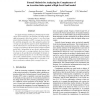Free Online Productivity Tools
i2Speak
i2Symbol
i2OCR
iTex2Img
iWeb2Print
iWeb2Shot
i2Type
iPdf2Split
iPdf2Merge
i2Bopomofo
i2Arabic
i2Style
i2Image
i2PDF
iLatex2Rtf
Sci2ools
VLSID
2005
IEEE
2005
IEEE
Formal Methods for Analyzing the Completeness of an Assertion Suite against a High-Level Fault Model
One of the emerging challenges in formal property verification (FPV) technology is the problem of deciding whether sufficient properties have been written to cover the design intent. Existing literature on FPV coverage does not solve this problem adequately, since they primarily analyze the coverage of a specification against a given implementation. On the other hand, we consider the task of determining the coverage of a formal specification against a high-level fault model that is independent of any specific implementation. We show that such a coverage analysis discovers behavioral gaps in the specification and prompts the design architect to add more properties to close the behavioral gaps. Our results establish that the coverage analysis task at this level is computationally complex, but it is possible to obtain a conservative estimate of the coverage at low cost.
| Added | 25 Jun 2010 |
| Updated | 25 Jun 2010 |
| Type | Conference |
| Year | 2005 |
| Where | VLSID |
| Authors | Sayantan Das, Ansuman Banerjee, Prasenjit Basu, Pallab Dasgupta, P. P. Chakrabarti, Chunduri Rama Mohan, Limor Fix |
Comments (0)

